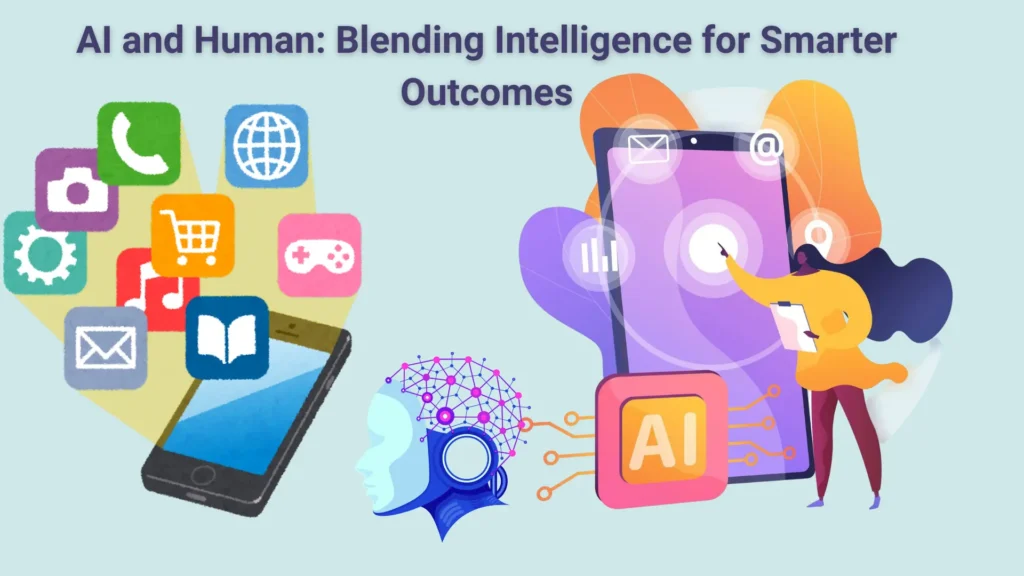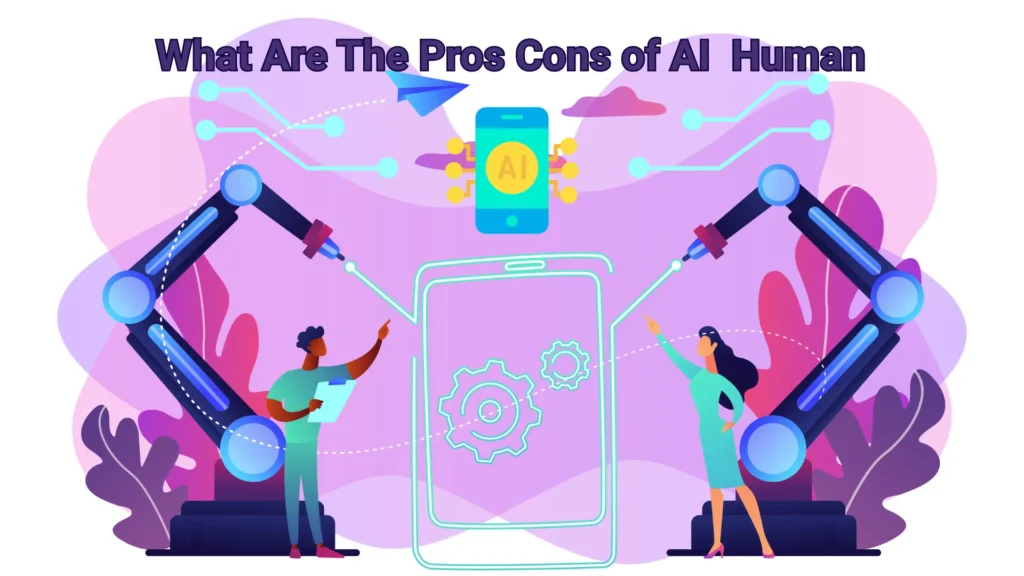AI and human collaboration in today’s digital environment is essential, as relying solely on artificial intelligence often leads to content that feels superficial or lacks emotional depth. While AI-generated text is fast and scalable, it misses the context and empathy that only human insight can provide. Conversely, workflows built entirely around human creators tend to be slower, less consistent, and more costly—making it challenging to scale content production or meet tight deadlines effectively.
Combining AI’s speed and data-driven capabilities with human creativity and judgment creates a powerful synergy. This hybrid model enables teams to deliver engaging, high-quality output at scale while preserving the authenticity, nuance, and strategic direction that only humans can provide. When executed correctly, this blend reduces turnaround time, improves consistency, and strengthens audience connection—all without compromising brand voice or human touch.
Top Trends in AI and Human Collaboration
AI and human collaboration is reshaping industries, blending machine efficiency with human creativity to deliver smarter, faster, and more emotionally resonant outcomes.
Co‑creation in Content Generation
Modern AI tools, like ChatGPT, Jasper, and Copy.ai, excel at generating brainstorming ideas, outlines, or first drafts based on a prompt. These AI platforms excel at generating brainstorming ideas, outlines, or first drafts based on a prompt—often including structural elements, bullet points, or SEO-focused content. Human creators then enhance the output by editing for tone, ensuring brand consistency, adding emotional nuance, and refining the flow. When combined, AI and human efforts streamline the process while preserving quality and authenticity.

Decision‑Support Systems
In fields like finance, healthcare, and business intelligence, AI and human collaboration plays a critical role. AI excels at processing vast amounts of data, detecting patterns, and flagging anomalies, but those insights are only as valuable as their interpretation. Human experts step in to review AI-generated analyses, validate findings, provide contextual understanding, and make strategic decisions. Together, AI and human intelligence create more informed, accurate, and impactful outcomes.
Automated Workflows
Repetitive or rule-based tasks—such as data entry, email scheduling, social media posting, or simple reporting—can be fully automated with AI-powered tools. Meanwhile, humans focus on creative strategy, relationship-building, and higher-level thinking. This shift not only improves efficiency but also raises morale by freeing professionals from monotonous work, allowing them to explore more meaningful challenges.
How to Use AI and Human
- Define Responsibilities Clearly
At the project’s outset, decide which tasks are suited for AI and which require human oversight. For example, AI can handle research, draft creation, and initial formatting, while humans oversee voice, tone, accuracy, and contextual relevance. - Create Feedback Loops
Establish a cycle where AI produces content, then humans review and refine it, highlighting errors or weak spots. Use those corrections to retrain or adjust AI prompts, boosting future performance and alignment with brand expectations. - Craft Effective Prompts
Prompt engineering matters. Include specifics like desired audience, tone, length, structure, and examples. A detailed prompt might request, “Write a 300‑word introduction with a conversational tone aimed at small business owners, including a short anecdote.” Better prompts equal better results. - Measure Performance
Track relevant metrics such as time saved, error rates, content engagement (click-through rates, time on page), and brand voice consistency. Use this data to iterate on prompt design, task allocation, and overall AI-human balance.
What’s New
- Explainable AI (XAI):
The latest AI platforms now include explainability features, showing why a particular suggestion was made. This transparency allows human reviewers to trust or challenge AI decisions more effectively. - Integrated Human aAI Platforms:
Tools like Jasper, Adobe Firefly, and Grammarly now include real-time suggestions, collaborative editing features, and dashboards that show both AI proposals and human revisions—all within the same interface. - Smart Bot Escalation:
Chatbots have become sophisticated enough to detect tone and sentiment. When they sense confusion, frustration, or emotional content, they automatically escalate the conversation to a human agent, improving customer experience and resolution quality.
AI‑Only vs Human‑Only vs Hybrid
| Approach | Pros | Cons |
| AI‑Only | Fast, scalable, cost-effective; 24/7 availability | May include factual errors, lack of nuance, and emotional detachment |
| Human‑Only | Creative, empathetic, culturally aware | Time-consuming, expensive, inconsistent quality |
| Hybrid | Balanced content: fast, accurate, emotional, on-brand | Requires workflow design, process coordination, and training |
This table helps illustrate why hybrid strategies outperform single-mode approaches in delivering speed, quality, and emotional resonance simultaneously.
Pros and Cons of the Hybrid Model
Pros:
- Speed and Scale: Automate repetitive steps and accelerate content cycles without quality loss.
- Emotional Engagement: Human oversight maintains tone, empathy, and brand authenticity.
- Consistency: AI ensures format and SEO requirements are met; humans refine voice and style.
- Adaptability: Response to real-time data or feedback becomes faster with AI involvement.
Cons:
- Setup Requirements: Defining clear roles, processes, and tooling often requires an initial investment.
- Training Needs: Teams need prompt-writing skills and basic AI literacy to collaborate effectively.
- Bias & Errors: AI may still incorporate bias or inaccuracies—humans must monitor and correct.
- Management Overhead: Overseeing AI-human handoffs and feedback systems needs governance.

Comparison: Popular AI Writing Tools in Hybrid Workflows
- ChatGPT (OpenAI):
Excels at ideation, brainstorming, and conversational tone. It’s free or integrated into paid tiers. Requires human editing to fix fact-checking and stylistic refinements. - Jasper.ai:
Built for marketing teams, includes templates, SEO support, and browsers. Offers integration for team collaboration and feedback. Some plans can be expensive, but the ROI comes from efficiency at scale. - Copy.ai & Writesonic:
Good for short-form content, ad copy, and brainstorming. Strong variety of tone options, but may require more editing for accuracy and factual consistency. - Grammarly Business:
Focuses on grammar, clarity, and style. Works alongside other AI tools—ideal for human editors finishing AI drafts. Less effective for generating original ideas or structure.
Teams often find that pairing a “creative” AI (ChatGPT/Jasper) with an “editing” AI (Grammarly) plus human review is the most effective hybrid combo.
FAQs
Is the hybrid approach truly cost-effective?
Yes. While there’s an upfront investment in tools and training, automation of repetitive tasks often leads to faster pipelines, fewer errors, and reduced labor costs, resulting in long-term ROI.
Will AI eventually replace humans?
No. Even the most advanced AI lacks human empathy, cultural nuance, and creative intuition. Humans remain essential for tone, judgment calls, and audience connection.
How much AI training does a team need?
Generally, just prompt-writing basics and workflow guidelines. Many platforms offer tutorials and templates. Within a few weeks, teams can build effective hybrid systems.
Can hybrid workflows fit any industry?
Absolutely. Marketing, customer support, healthcare, finance, legal compliance, education, journalism, and creative agencies all benefit from AI handling volume while humans focus on strategy, ethics, and emotional impact.
What about data privacy?
Enterprise tools offer on-prem or privacy-compliant options. Sensitive data can be processed securely using private models, allowing hybrid workflows without compromising compliance.
Conclusion
A thoughtfully designed hybrid of AI and human expertise enables organizations to achieve speed, scalability, emotional resonance, and strategic alignment—all at once. AI handles data-heavy, repetitive tasks, while humans ensure quality, tone, and creativity. As platforms evolve with explainable features and smart collaboration tools, the hybrid model is becoming not only powerful but essential.
One practical example of this synergy is the use of an AI chatbot in customer interactions. While the chatbot manages routine inquiries instantly and efficiently, human agents step in for complex or emotionally sensitive issues—creating a seamless balance between automation and empathy.
To succeed, start with:
- Clearly defined AI versus human roles
- Well-crafted prompts and feedback loops
- Performance tracking and continuous iteration
- Training for team members on both tool use and collaboration
By following this roadmap, you can harness the best of both worlds—achieving faster, smarter, and more meaningful outcomes.
